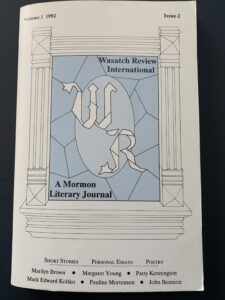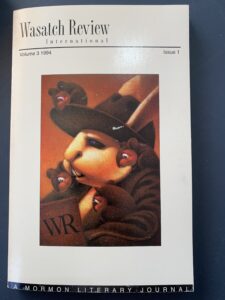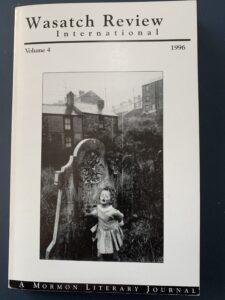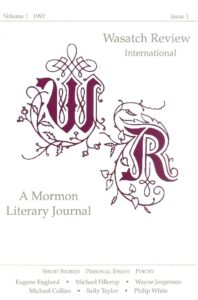 Scans of the six issues of Wasatch Review International, a Mormon literary journal published in 1992-1996, are now available. The journal was the creation of Tory C. Anderson, who served as editor throughout the journal’s run, and it was published in Orem, Utah. It published short fiction, poetry, personal essays, drama, critical essays, and book reviews. Among the authors published in the journal were Eugene England, Bruce W. Jorgensen, Margaret Blair Young, Michael Fillerup, John Bennion, Timothy Liu, Dennis Clark, and J. Scott Bronson. WRI was an independent journal, with no institutional affiliation, but was supported by BYU faculty and members of the Association for Mormon Letters. It was the only journal dedicated to publishing Mormon literature and criticism in the mid-1990s, and was a predecessor to the AML’s literary magazine Irreantum.
Scans of the six issues of Wasatch Review International, a Mormon literary journal published in 1992-1996, are now available. The journal was the creation of Tory C. Anderson, who served as editor throughout the journal’s run, and it was published in Orem, Utah. It published short fiction, poetry, personal essays, drama, critical essays, and book reviews. Among the authors published in the journal were Eugene England, Bruce W. Jorgensen, Margaret Blair Young, Michael Fillerup, John Bennion, Timothy Liu, Dennis Clark, and J. Scott Bronson. WRI was an independent journal, with no institutional affiliation, but was supported by BYU faculty and members of the Association for Mormon Letters. It was the only journal dedicated to publishing Mormon literature and criticism in the mid-1990s, and was a predecessor to the AML’s literary magazine Irreantum.
In a 2000 Sunstone Symposium presentation, Anderson described the history of the journal. He first became interested in the possibilities of Mormon literature while taking an English class at BYU from Douglas Thayer in 1989. He changed his major to English, and received both a B.A. and an M.A. from the BYU English Department, with Leslie Norris as his main advisor. While there, he had stories published by The New Era. The editor, Richard Romney, was enthusiastic about Anderson’s stories, when he rejected a story that Anderson thought was fair without idealizing Mormons, and did not feature the conversion of non-Mormons, he came up with the idea of creating a journal that could published stories of “real Mormon lives, uncorrelated”. While Sunstone and Dialogue were publishing a few such stories, Anderson craved a journal dedicated to the idea, and thought that others would as well. He went to Eugene England with his idea, and England gave him encouragement and his first financial donation.
About the magazine’s name, Anderson wrote in the introduction of the first issue, “Many years ago, in the days of Ernest L. Wilkinson, Clinton F. Larson attempted to start a journal entitled Wasatch Review. For whatever reason—perhaps it just wasn’t time yet—the Wasatch Review was aborted and BYU Studies, a fine academic journal, took its place. Well, Professor Larson, the Wasatch Review has been born again and this time may it grow to maturity while helping its readers do the same.” He also noted that “The ‘International’ portion of our title is there for a purpose,” and that they hoped to eventually receive submissions from Mormons from around the world. Furthermore, in 1983 England had suggested the creation of an AML literary journal, tentatively named Wasatch, to AML associates. The proposal was not taken up, but perhaps England suggested the name to Anderson.
In a Deseret News feature article about the founding of the journal, Anderson gave three goals of the journal. “1. Emphasize human beings, not Mormons. Make the journal about people first. 2. Give the publication an international flavor by drawing contributions from all over the globe. 3. Go for the middle ground. Avoid being either too conservative or too liberal. Look for perspective.” In the opening essay of the journal, Anderson wrote, “We are looking for authors who are interested in the Mormon culture but who have nothing to prove. We seek literature that does not purposefully attempt to prove the Church is true or prove that it is false; literature that does not attempt to prove Mormons are the happiest people in the world or the biggest hypocrites. We are looking for literature that as honestly as the author can articulates our triumphs and tragedies, our righteousness and sinfulness, our joys and despairs, for the cause of knowing ourselves better as a people, as a culture, and as individual human beings so that we can, if we choose, live more fully—more wholly.”
Raising $600 dollars in donations, Anderson and his associates bought a mailing list of 1000 names from Sunstone. They were able to sell 300 subscriptions. The journal was originally envisioned as biannual, and two issues were published in both 1992 and 1993. One issue was published each in late 1994 and early 1996, and then the journal closed. Anderson reports that burnout was the main cause for the journal’s termination—his family and work commitments overwhelmed him, and he was not able to round up enough financial and logistical support to keep the journal running. The journal never had any institutional support, something that AML’s Irreantum would enjoy in its initial print run. Anderson reports that the possibility of AML supporting the magazine directly was never discussed. The magazine held three writing conferences to raise money from 1993 to 1996, one held at Salt Lake Community College and two at Utah Valley State College. Anderson tried to apply for grants, but says that the granting institutions were wary of supporting a journal with religious ties. At one point there was discussion with Curtis Taylor and Stan Zenk of Aspen Books, who proposed buying the magazine, but Anderson decided that he did not want to lose his independence. The third Writing Conference, held at UVSC in October 1996, appears to have been the journal’s final event.
During the years editing the WRI, Tory Anderson had a short story “Epiphany”, published in Dialogue 28:3 (1995), which won the 1995 AML Short Fiction Award. His essay “Just the Fiction, Ma’am,” which first appeared in WRI 1:2, was anthologized in Tending the Garden: Essays on Mormon Literature. Anderson served as fiction editor of Irreantum from its founding issue in March 1999 to volume 4:4 in Winter 2002-2003. He worked in telecommunications and computer technology, and currently resides in Levan, Utah. Since 2011 he has self-published a number of books, including the YA novel Jacob and Lace, and The Peculiar Children of Bus 13 series, and has had pieces run in the The New Era.
The other three founding editors, Valerie Holladay, Henry Miles, and Paul Rawlins, were all current or recent BYU English department MA students. Valerie Holladay, who passed away in 2011, was Anderson’s main assistant throughout the journal’s run. They had previously worked together at Inscape, the BYU literary journal. She would later serve as an editor at Irreantum in 2006-2008. Henry Landon Miles was a retired former Foreign Service Officer in his late 50s who focused on family history. Paul Rawlins’ 1996 short fiction collection No Lie Like Love: Stories (University of Georgia Press) won a Flannery O’Connor Award. Other associate editors in subsequent issues were Leslee Thorne Murphy, MaryJan Munger, Julia Konopasek, Kaydean McInnis, Tim McInnis, and Kent Wallace.
Wasatch Review International: Table of Contents
Letter from the editor
In search of wholeness. Tory C. Anderson
Personal essays
The Dawning of a Brighter Day: Mormon Literature after 150 Years. Eugene England
Companionship. Valerie Holladay
Germany (1947-48): The Maturing of an Imagination. Douglas Thayer
Short stories
Two Years Sunday. Wayne Jorgensen
The Conveyor. Harlow Clark
Novel excerpt
“Nancy”, from A River, a Rock. Michael Fillerup
Poetry
Piling cords. William Powley
Brand. Dixie Partridge
Where the Water Comes Out of the Mountain. Philip White
West. Philip White
What the Magdalene saw. Timothy Liu
Tattoo. K. Randall Kimball
The Dionysian Hierarchy First Notices Moroni and his Friends. Michael Collings
Prima Vera. Michael Collings
Hurricane Mid-Atlantic. Sally Taylor
Strangers. Donnell Hunter
The Second Time. Donnell Hunter
Welfare Farm Raisins. Brian J. Fogg
Book reviews
Healing the Streams: A Review of Salvador by Margaret Young. Karla and John Bennion
A New Voice: A Review of Thoughts on a Grasshopper by Louise Plummer. Valerie Holladay
Criticism to Guide our Shakespeares and Miltons: A Review of Talents and Technicians: Literary Chic and the New Assembly Line Fiction by John W. Aldridge. Mark Edward Koltko
Letter from the Editor
Just the Fiction, Ma’am. Tory C. Anderson
Short Stories
The Valley of Bones. Patty Redd Kennington
The Fatherly Heaven and the Motherly Earth. Harlow Soderborg Clark
The Burial Pool. John Bennion
Brothers. Margaret Blair Young
Novel Excerpt
Chapter 1 from House on the Sound. Marilyn McMeen Brown
Personal Essays
Jagran. Loretta M. Sharp
The Quilting Effect. Pauline Mortensen
Constrictions, Potentials, and Margins: Thoughts on Mormon Writers. Mark Edward Koltko
Poetry
Trains. Lisa Madsen deRubilar
Calf Joy. Lisa Madsen deRubilar
Pablo Campues, Saint. H. Landon Miles
November. Sally Tavlor
God’s Pagan. David Parman
My River. David Parman
Living in Skin. Dennis Clark
At St. Bartholomew the Great. Robert A. Rees
Debtor. MaryJan Munger
Morning Glory. Maryan Munger
Annunciation. MaryJan Munger
Book Review
Personal and Political Activism: A Review of Refuge. Phillip A. Snyder
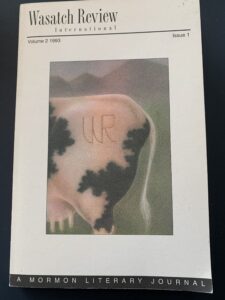 Volume 2, Number 1 (June 1993)
Volume 2, Number 1 (June 1993)
Editor’s Note
Mormon Literature: That Was Then, This Is Now, What Is Next? Valerie Holladay
Short Stories
Ten Letters to Jenny. Dianne M. Black
God on Donahue. Margaret Young
Personal Essays
The Trial of John Horne Miles. Henry Landon Miles
The Vicissitudes of Serving in the Bishopric. Richard H. Cracroft
Monte Cristo. Eugene England (1993 AML Personal Essay Award winner)
Poetry
Lines for Morning. Ellen Kartchner
Ode to Basil. Ellen Kartchner
Koli Musicians in the Taiwan Folk Arts Museum. Loretta M. Sharp
Dove Descending. Harlow Söderborg Clark
Duck Hunting. Christopher Robins
Sole Makers. Russell Moorehead
Book Reviews
The Paradoxical Price of Freedom: Church and Literature as “Liberating Form,” A Review of Liberating Form: Mormon Essays on Religion and Literature, by Marden J. Clark. Bryan Waterman
A Mormon Woman’s Intimate Review: A Review of Secret Ceremonies: A Mormon Woman’s Intimate Diary of
Marriage and Beyond, by Deborah Laake. Julie J. Nicholes
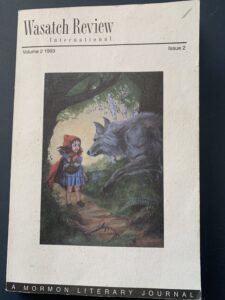 Volume 2, Issue 2 (December 1993)
Volume 2, Issue 2 (December 1993)
Letter from the Editor
Where Have Al the Questions Gone? Tory C. Anderson
Short Stories
Missionary Stories. Edgar C. Snow
Where No Tourists Are. Tom Hafen
The Journey of the Magi. Jerry Johnston
Family Resemblances. Susan Elizabeth Howe
Personal Essays
The Utah Landscape: A Personal Reflection on Land and Family. Andy Bay
The Prophet. Mikel Vause
Celebrating Mormon Values: Wallace Stegner (1909 -1993) and the Latter-Day Saints. Richard H. Cracroft
Poetry
Submissions. Mary Ann Losee
Poem for the Artist. Mary Ann Losee
Blue. Mary Ann Losee
West on a Greyhound Bus. Mary Ann Losee
Riding a One-Eyed Horse. Henry Taylor
Buildings and Grounds. Henry Taylor
Girl at Thirteen. Giles H. Florence, Jr.
Standing in White. Giles H. Florence, Jr.
Feelings. Giles H. Florence, Jr.
Book Review
Opening the Door a Little Wider: A Review of My Hard Bargain by Walter Kirn. Christopher Bigelow
Letter from the Editor
Where Are the Mormon Writers? Tory C. Anderson
Essays
Ringing Up Zero. Tryn Paxton
Plantains. Lisa Madsen de Rubilar
Short Story
Leaving the Farm. Myrna Marler
Novel Excerpt
The House Away from Home, from Road to Covered Bridge. Marilyn Brown
Drama
Confessions. J. Scott Bronson
Interview
An Interview with John Bennion
Poetry
Ordination Day. Joel Baldwin
Transcendental. Paul Swensen
Review of Eight. E. Leon Chidester
Snow. Jerry Johnston
Book Review
“The Paradox of Salvation” a Review of She Needed Me by Walter Kirn. Valerie Holladay
Short Stories
Missionary Rules. Tory C. Anderson
Cub River. Paul Rawlins
Novel Exerpt
Jonah: Sailing to Tarsish. From The MTC: Set Apart. Benson Y. Parkinson
Essays
Somebody’s Mother. Teresa Holladay
Heritage of Hostility: The Mormon Attack on Fiction in the 19th Century. B. W. Jorgensen
Roughly One ofthe R’s: Some Notes of a BYU Fiction Teacher (with a Pedantry of Endnotes). B.W. Jorgensen
(These two essays were given the 1996 AML Criticism Award.)
Poetry
Tell Me Tomorrow. E. Leon Chidester
JobinWinter. E. Leon Chidester
Slow Dance No. 1084. Sharlee Mullins Glenn
Book Reviews
All God’s Critters Got a Place in the Choir by Laurel Thatcher Ulrich and Emma Lou Thayne. Reviewed by Julea Z. Konopasek
Statehood by Marilvn Brown. Reviewed by Julia Z. Konopasek
Desert Quartet: An Erotic Landscape by Terry Tempest Williams. Reviewed by Kaydean Mcinnis

